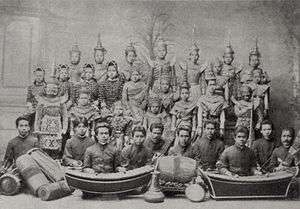Lakhon nai
Lakhon nai (Thai: ละครใน, pronounced [lā.kʰɔ̄ːn nāj]) is a Thai performing art originating in the royal court of Thailand (formerly Siam). It features slow choreography accompanied by a piphat ensemble. The repertoire of lakhon nai consists of only four epics; the Ramakian, Unarut (Aniruddha), Inao (Panji), and Dalang (a greater version of Inao).[1]:67 A variation of this genre with male performers is called lakhon nai phu chai (Thai: ละครในผู้ชาย; RTGS: lakhon nai phu chai).
| Lakhon nai |
|---|
 A Siamese theatrical group c. 1900 |
|
| Burma |
| Cambodia |
|
| Indonesia |
|
| Laos |
| Malaysia |
| Philippines |
| Thailand |
| Vietnam |
Etymology
Lakhon nai is believed to be a contraction of lakhon nang nai (ละครนางใน), or 'theatre of the women of the palace'.[1]:63 It was also known as lakhon khang nai (ละครข้างใน, literally, 'theatre of the inner court') and lakhon nai phra ratchathan (ละครในพระราชฐาน, literally, 'theatre of [belonging to] the king').[2]
References
- Brandon, James R (1967). Theatre in Southeast Asia. Harvard University Press. ISBN 0674875877. Retrieved 16 October 2017.
- http://www.anurakthai.com/thaidances/thaidrama/thaidrama3.asp%5B%5D
.svg.png)